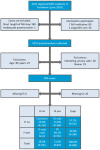What characteristics predispose to continence in nursing home residents?: a population-based cross-sectional study
- PMID: 24470319
- PMCID: PMC4491350
- DOI: 10.1002/nau.22563
What characteristics predispose to continence in nursing home residents?: a population-based cross-sectional study
Abstract
Aims: To compare characteristics of both continent and incontinent residents in Nursing Homes (NHs) and to explore what predicts continence and severity of incontinence.
Methods: A population-based cross-sectional study was performed in nursing homes in one Norwegian municipality. Registered nurses filled in a questionnaire on behalf of the patients.
Results: We found that 25.4% of the NH residents were continent, 31.8% had urinary incontinence alone, 2.6% had fecal incontinence alone and 40.2% had double incontinence. Continent residents were characterized by being in short-term care, shorter stay in NH, less cognitive and physical impairment, less Parkinson's disease, stroke, constipation, and less diarrhea and more independence in activities of daily living (ADL). Residents with fecal incontinence alone were characterized by more diarrhea, less cognitive impairment and less dependency in ADL such as feeding and grooming. Residents with urinary incontinence alone were characterized by having some degree of ADL dependency, less diarrhea, and less diabetes. Residents with double incontinence were characterized by being in long-term care, a longer length of stay in NH, cognitive impairment, stroke, constipation, diarrhea, and dependency in ADL. Severity of incontinence was associated with dependency in ADL and cognitive impairment, diarrhea, length of stay in NH and lower age.
Conclusions: About 25% of NH residents were continent. Double incontinence and urinary incontinence only were prevalent conditions in NHs, while FI alone was rarer. With the exception of diarrhea as a cause of FI, it appears that FI alone, UI alone, and DI may have common causes and development.
Keywords: characteristics; cross sectional study; epidemiologic study; fecal incontinence; homes for the aged; incontinence; nursing homes; prevalence studies; residential facilities; urinary incontinence.
© 2014 The Authors. Neurourology and Urodynamics published by Wiley Periodicals, Inc.
Figures
Similar articles
-
Prevalence and correlates of fecal incontinence among nursing home residents: a population-based cross-sectional study.BMC Geriatr. 2013 Aug 30;13:87. doi: 10.1186/1471-2318-13-87. BMC Geriatr. 2013. PMID: 24119057 Free PMC article.
-
Prevention of urinary and fecal incontinence in adults.Evid Rep Technol Assess (Full Rep). 2007 Dec;(161):1-379. Evid Rep Technol Assess (Full Rep). 2007. PMID: 18457475 Free PMC article. Review.
-
Nationwide survey of continence status among older adult residents living in long-term care facilities in Japan: The prevalence and associated risk factors of incontinence and effect of comprehensive care on continence status.Geriatr Gerontol Int. 2020 Apr;20(4):285-290. doi: 10.1111/ggi.13872. Epub 2020 Jan 28. Geriatr Gerontol Int. 2020. PMID: 31991532
-
Interactions of Factors and Profiles of Incontinent Nursing Home Residents and Hospital Patients: A Classification Tree Analysis.J Wound Ostomy Continence Nurs. 2016 Jul-Aug;43(4):407-13. doi: 10.1097/WON.0000000000000232. J Wound Ostomy Continence Nurs. 2016. PMID: 27196685
-
The Prevalence, Incidence, and Correlates of Fecal Incontinence Among Older People Residing in Care Homes: A Systematic Review.J Am Med Dir Assoc. 2019 Aug;20(8):956-962.e8. doi: 10.1016/j.jamda.2019.03.033. Epub 2019 May 23. J Am Med Dir Assoc. 2019. PMID: 31129021
Cited by
-
Exploring the concurrent validity of the nationwide assessment of permanent nursing home residence in Denmark - A cross-sectional data analysis using two administrative registries.BMC Health Serv Res. 2017 Aug 29;17(1):607. doi: 10.1186/s12913-017-2535-2. BMC Health Serv Res. 2017. PMID: 28851353 Free PMC article.
-
Female double incontinence: prevalence, incidence, and risk factors from the SABE (Health, Wellbeing and Aging) study.Int Urogynecol J. 2018 Feb;29(2):265-272. doi: 10.1007/s00192-017-3365-9. Epub 2017 Jun 15. Int Urogynecol J. 2018. PMID: 28620790
-
Time to and predictors of dual incontinence in older nursing home admissions.Neurourol Urodyn. 2018 Jan;37(1):229-236. doi: 10.1002/nau.23279. Epub 2017 Apr 13. Neurourol Urodyn. 2018. PMID: 28407296 Free PMC article.
-
Toileting difficulties in older people with and without dementia receiving formal in-home care-A longitudinal study.Nurs Open. 2019 May 17;6(3):1055-1066. doi: 10.1002/nop2.289. eCollection 2019 Jul. Nurs Open. 2019. PMID: 31367431 Free PMC article.
-
Continence Status and Presence of Pressure Skin Injury among Special Elderly Nursing Home Residents in Japan: A Nationwide Cross-Sectional Survey.Geriatrics (Basel). 2021 Mar 26;6(2):34. doi: 10.3390/geriatrics6020034. Geriatrics (Basel). 2021. PMID: 33810408 Free PMC article.
References
-
- DuBeau CE, Kuchel GA, Johnson T, et al. Incontinence in the frail elderly: Report from the 4th International Consultation on Incontinence. Neurourol Urodyn. 2010;29:165–78. - PubMed
-
- Offermans MP, Du Moulin MF, Hamers JP, et al. Prevalence of urinary incontinence and associated risk factors in nursing home residents: A systematic review. Neurourol Urodyn. 2009;28:288–94. - PubMed
-
- Long MA, Reed LA, Dunning K, et al. Incontinence-associated dermatitis in a long-term acute care facility. J Wound Ostomy Continence Nurs. 2012;39:318–27. - PubMed
-
- Burge E, von Gunten A, Berchtold A. Factors favoring a degradation or an improvement in activities of daily living (ADL) performance among nursing home (NH) residents: A survival analysis. Arch Gerontol Geriatr. 2013;56:250–7. - PubMed
-
- OECD Health Project. Long-term care for older people. Paris: OECD; 2005.
Publication types
MeSH terms
LinkOut - more resources
Full Text Sources
Other Literature Sources
Medical



